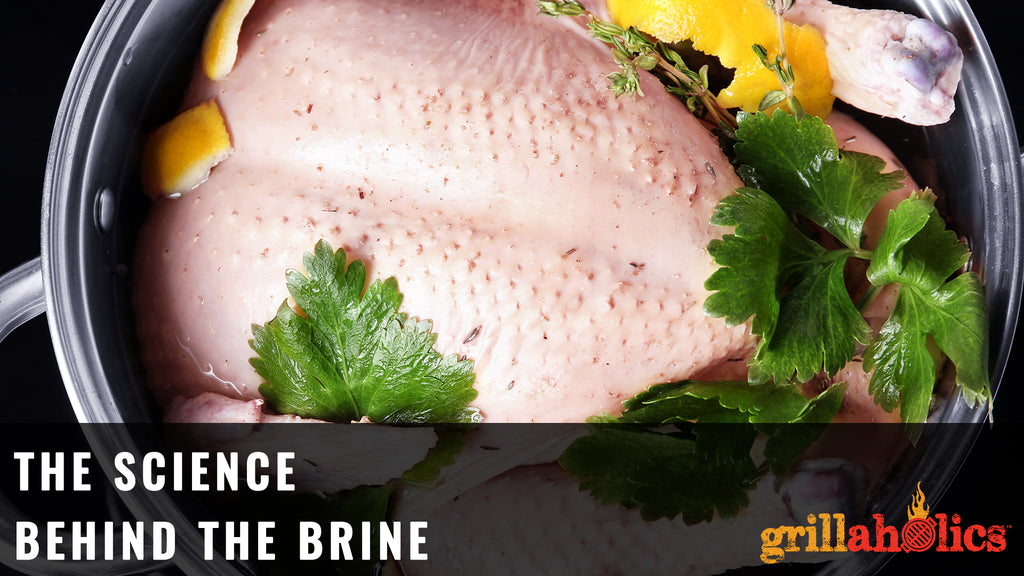The Science Behind The Brine
Posted by Jake Eller on
There’s no shortage of hotly-debated subjects amongst home cooks and grill fanatics alike. Amongst these subjects is the idea of brining your meat.
For the unindoctrinated, brining refers to letting a protein sit in a saltwater solution for a predetermined amount of time, before cooking. Some folks will never roast a bird or loin without brining, while others wouldn’t even consider wasting their time with a brine. We’ve heard from both sides, loud and clear. Today, we are going to get to the bottom of this ages-old debate, once and for all...with science!
The short answer: brining works.
The idea of brining is fairly simple. Lean meats are soaked in saltwater before grilling, in an effort to keep them tender and moist. This can be applied to all kinds of meats, from pork loins to thanksgiving turkeys. Looking at the science of the brine, the explanation for it is also pretty straightforward.
Think of your protein as a wet towel. When you cook it, the fibers of the meat tighten and shrink. Like twisting a wet towel, this forces the water to leave the protein. The result is a more dry, cooked product than the one you had to begin with. Moisture loss can create up a 30% decrease in net weight during the cooking process. According to some reports, a good brine can bring that all the way down to 15%.
It’s important to note here, though, that this towel-twisting process really only occurs over about 150 degrees Fahrenheit. This is why the brining conversation usually occurs to poultry and pork, where you’re going to be pushing up into that temperature bracket to achieve doneness.
The idea of a brine is to super-saturate your protein with water before cooking. That way, even with the moisture loss from the cooking or grilling process, the meat still contains a reasonable about of water to create a great, tender texture.
During the brining process, the salt is actually doing the ‘heavy lifting’, so to speak. The salt agitates the muscle fibers as a near-abrasive. It separates and spreads out the proteins within your meat, making space for water to enter. In addition, the salt will work to break down some of the tougher muscle fibers, tenderizing the meat even further.
While some will point to osmosis as the function occurring within a brine, the science has proven this to be incorrect. The process of osmosis is basically low-solute (in this case, salt) water moving across a membrane into an area of high solute concentration. At its core, this would mean there is no upper limit to how much salt should be in a brine. This is decidedly false.
So how much salt do we need to put in our brine to properly agitate the fibers?
Well, K. Jenji-Lopez at the Food Lab has a surprising answer. If the osmosis theory were true, it would be ‘the more salt the better’, but Lopez found no difference between the result of a 35% brine and a 6% brine. Between his research and the work of food scientists at the University of Kentucky, we can come to the conclusion that a 5 to 6% brine solution is the way to go. Per gallon of water, that’s going to be about 7 ounces of salt -- or ¾ cup if you haven’t got a scale handy.
Brines don’t have to be boring, either! In fact, a brine is a great way to introduce new, interesting flavors to your protein. The salt opens up the muscle fibers and allow water in, sure! But it also allows for anything else in the brine to penetrate the product. We would encourage you to experiment -- try adding herbs, spices, or even other liquids to your brine. As long as you keep the salt content within your brine, there are endless possibilities. One of our favorites? Apple cider in a poultry brine.
And that’s it, folks! For us, brining presents two benefits through a very straightforward process. The salt tenderizes, and allows the meat to retain more moisture through the cooking process. On top of that, a brine is a great way to impart some new, exciting flavors into your roast. Try it for yourself! The proof is in the pudding, and the science backs it up. Next time you run into any brining naysayers, send them our way -- we’d like to have a word!



